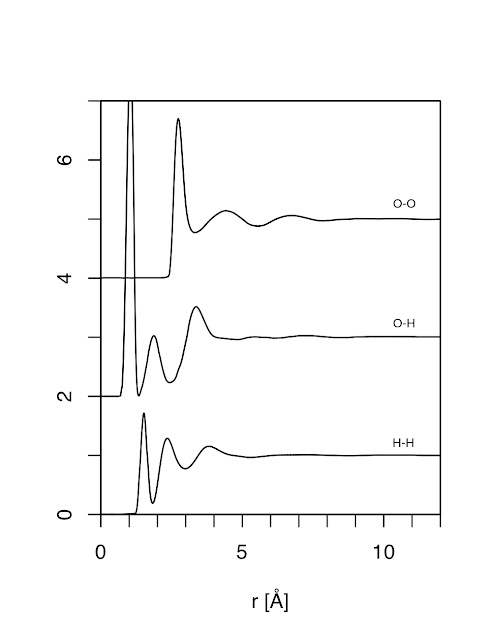Site-site radial distribution functions, sometimes called g(r) for short, are one of the most important measured quantities in molecular simulations. As usual, wikipedia has a nice overview of them. Probably the most famous non-trivial g(r) is the water oxygen-oxygen radial distribution function. It's often taught in statistical mechanics courses that it's possible to compare a simulation g(r) with X-ray or neutron-diffraction experiments with a simple Fourier transform. In fact, this is almost never the case due to sources of error in experiments. Check out the Introduction to this article by AK Soper for more info on the kinds of error which prevent the simple Fourier transform from converting experimental structure factors to a g(r).
In any case, the point of this post is to put the raw data for an experimental g(r) for water. The AK Soper article uses the empirical potential structure refinement method for converting experimental neutron diffraction data at 298 K 1 bar into the three radial distribution functions for water (O-O, O-H, H-H). This is the best method I know of for obtaining these radial distribution functions and this is the data used to test the TIP4P/2005 water model. I've extracted the data from their paper and made it available here. Make sure to cite their paper if you use the data in a publication. Hopefully these g(r)s will help you in creating your own new special water models! See the figure below the break:
I don't think I can legally reproduce the image from the paper on my blog, but compare Figure 6 from the AK Soper article with:
In any case, the point of this post is to put the raw data for an experimental g(r) for water. The AK Soper article uses the empirical potential structure refinement method for converting experimental neutron diffraction data at 298 K 1 bar into the three radial distribution functions for water (O-O, O-H, H-H). This is the best method I know of for obtaining these radial distribution functions and this is the data used to test the TIP4P/2005 water model. I've extracted the data from their paper and made it available here. Make sure to cite their paper if you use the data in a publication. Hopefully these g(r)s will help you in creating your own new special water models! See the figure below the break:
I don't think I can legally reproduce the image from the paper on my blog, but compare Figure 6 from the AK Soper article with:
